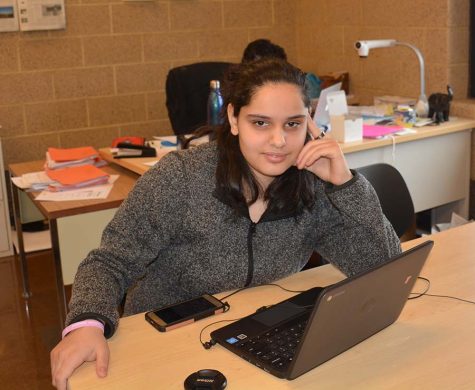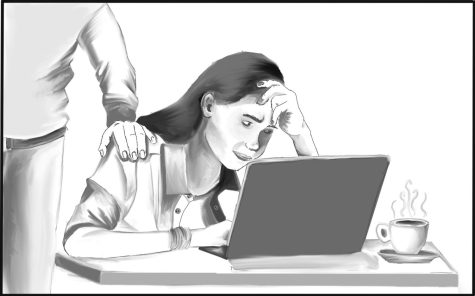Teen Mental Health Issues Increasing Nationwide

Image by Gan Khoon Lay via the noun project
The incidence of anxiety and depression in high school and college students has increased dramatically in recent years.
Researchers found a 37% increase in major depressive episodes among teens from 2005-2014. According to the National Survey on Drug Use and Health, these incidents have been more than twice as high among teenage girls than teenage boys.
According to the New York Times, increasingly rigorous academic course loads, greater demands from extracurricular activities and an increasingly selective college admissions process have contributed to the stress that many teens are feeling.
Others have attributed the increase in teenage mental health issues to the rise of smartphone use.
Depression, anxiety and other mental illnesses are often comorbid, meaning teens can suffer from more than one diagnosis at the same time, according to the Anxiety and Depression Association of America (ADAA).
Mental illness can be triggered by abuse, conflict in the home, peer relationship issues, stress, or by neurochemical imbalance in the brain, guidance counselor Liz Osicki and S.A.Y counselor Mallory Molls explained in a joint interview.
Addressing mental health issues in teens can be challenging in part due to social stigma. If it is hard for adults to talk about their feelings, it is even harder for teens.
Information About Anxiety and Depression
Anxiety is the most common mental health disorder, according to ADAA.
“Anxiety is easy to dismiss or overlook, partially because everyone has it to some degree,” Philip Kendall told The New York Times. Kendall is the director of the Child and Adolescent Anxiety Disorders Clinic at Temple University in Philadelphia.
Anxiety Disorder is defined as “a mental health disorder characterized by feelings of worry, anxiety, or fear that are strong enough to interfere with one’s daily activities.”
According to the Mayo Clinic, some of the most common symptoms of anxiety include fatigue, restlessness, irritability, racing thoughts, unwanted thoughts, excessive worrying, a feeling of impending doom, insomnia, heart palpitations, nausea and poor concentration.
Depression is another of the most common mental health disorders. It commonly goes hand in hand with anxiety. It is defined as “a mental health disorder characterized by persistently depressed mood or loss of interest in activities, causing significant impairment in daily life.”
In addition to shared symptoms with anxiety, depression symptoms include loss of appetite, weight gain or weight loss, hopelessness, guilt, loss of interest, mood swings, excessive crying, social isolation, suicidal thoughts, excessive hunger or slowness and lack of interest in everyday activities, according to the Mayo Clinic.
A 2015 study from NYU found that students at competitive high schools, vying for increasingly selective college admissions, experience chronic stress, which compromises mental health functioning.
Mental Illness Statistics at Beachwood
The Beachcomber conducted a survey in November and early December to determine the level of anxiety and depression symptoms BHS students were experiencing, based on anonymous self-reporting.
113 students from grades 9-11 were first asked to identify if they had been diagnosed with generalized anxiety disorder (GAD), social anxiety disorder (SAD), obsessive compulsive disorder (OCD), post traumatic stress disorder (PTSD), panic disorder and/or depression.
In each grade, the survey was given to one honors English and one college prep English class.
Students were asked to check off common symptoms of anxiety that they experience consistently. Next, students were instructed to check off how many of these symptoms they associate with school. Finally, students were asked to answer whether they had been treated for anxiety and/or depression.
Overall Results (113 Students)
- Restlessness showed up as the most common symptoms for freshman (23 students) as well as sophomores (20 students). Fatigue proved to be a common symptom in both the sophomores (21 students) and the juniors (30 students). The juniors (27 students) and freshman (20 students) both had poor concentration as a prominent symptom of anxiety and/or depression.
- Freshman, sophomores, and juniors all noted that 1-5 of the symptoms listed were associated with school/school work.
- The most common mental illness in all three grades was depression. Each followed by GAD (generalized anxiety disorder).
- 86 out of 113 students surveyed do not receive any treatment for depression and/or anxiety, while 27 students do receive treatment.
Freshman Results (35 Students)
- Out of fatigue, restlessness, irritability, racing thoughts, unwanted thoughts, excessive worrying, fear of impending doom, insomnia, nausea, palpitations, and poor concentration, the three most common symptoms for 9th graders (in order) were restlessness (23 students), poor concentration (20 students) and irritability (17 students).
- Almost all of the freshman students who took the survey agreed that 1-5 of the symptoms they checked off were associated with school/school work.
- Throughout the freshman grade, the most common mental illness people had been diagnosed with was depression, (7 students), followed closely by GAD (6 students).
- Out of all the freshman students who took the survey, 26 of the students receive no treatment while 9 students do receive some form of treatment.
Sophomore Results (38 Students)
- Between the symptoms listed above, the three most common for 10th grade, (in order) were irritability and fatigue (tied for first with 21 students), followed by restlessness (20 students).
- Much like the freshmen, a vast majority of 10th grade students who took the survey agreed that 1-5 of the symptoms they had to check off were associated with school/school work.
- For the sophomores, the most common mental illness students had been diagnosed with was depression (12 students). After depression, the next was GAD (6 students).
- Out of all the sophomore students who took the survey, 26 of the students receive no treatment while 12 students do.
Junior Results (40 Students)
- The three most common symptoms in the 11th grade (in order) were fatigue (30 students), followed by excessive worrying (29 students) and poor concentration (27 students).
- Like the sophomores and freshmen, most juniors associated 1-5 of the symptoms with school/school work.
- The juniors’ most common mental illness was a tie between depression and GAD (6 students).
- Out of all the juniors who took the survey, 34 of the students receive no treatment while 6 students do.
Social Media’s Role In Affecting Mental Health
Jean Twenge, a Psychology Professor at San Diego State University, published an article in The Atlantic in September titled Have Smartphones Destroyed a Generation? The article details the negative effects of smartphones on teenagers’ relationships and mental health.
Twenge calls the current generation of teens iGen, and provides data linking smartphones to decreases in the time that teens spend together in person, to decreases in dating, to feelings of loneliness and to sleeplessness.
Twenge asked her students what they do with their smartphones at night.
Most responded that they keep it under their pillows, or at least within arms reach.
“They checked social media right before they went to sleep, and reached for their phone as soon as they woke up in the morning,” Twenge wrote.
She attributes cell phone addiction to a loss of sleep as well as constant bombardment of social media, which contributes to teen’s anxiety in a variety of ways.
“Social media creates an environment of comparison,” Molls said.
“Students are also willing to speak poorly of their peers anonymously online whether it’s through social media or texting, rather than say something rude or mean to their face,” Molls said. “[In teenage years] you don’t have as much impulse control or thinking about long-term consequences.”
According to a Daily Mail, cutting back on social media is an effective strategy to address anxiety. This is because in this generation most students have a device that only shows their life how they want people to see it. So when others’ lives appear to be perfect, for somebody who struggles with anxiety, their mind will “find something to focus on and then start filling [their] mind with worst case scenarios.”
On top of comparing one’s life to others, social media also creates a fear of missing out. According to mental health specialists at Anxiety.org, “pictures of a party where the user was not invited, or yet another wedding they weren’t able to attend…” seeing this can “take a toll on self-esteem.”
Does Therapy Really Help?
Many teens are hesitant to ask for help for mental health issues, according to Time.
According to Depression and Bipolar Support Alliance, (DBSA) it is important to find the most appropriate treatment for the individual’s needs.
There are many different therapists and therapy styles. If one therapist can’t help, there are always other professionals who might be able to.
“If a student is struggling and is willing to go talk to a counselor, then the counselor can always help find resources outside of school to assist with the situation,” Osicki said.
“Depending on the student’s needs, there are other resources that we can hook you up with,” Molls said.
Talking to someone can always be beneficial; however, it can be hard to talk to a friend or family member due to fear of judgement. That’s why therapy can be a useful option.
“Therapists try to listen to and help you come up with your own solutions,” Osicki said.
According to the American Psychological Association, anxiety disorders tend to respond very well to therapy. Cognitive-behavioral therapy and exposure therapy are two types that prove to be the most useful when battling an anxiety disorder. Exposure therapy helps people with anxiety to actually confront and face their fears head on while cognitive-behavioral therapy focuses on the thoughts that people have that produce the anxiety.
What You Can Do If You’re Struggling With Mental Illness
According to the American School Counselor Association (ASCA), stress-reduction strategies can be tremendously helpful.
While it is impossible to give students an anxiety-free life, it is important to give them strategies to handle the stress. Connecting with others is also essential. Another suggestion is to get enough sleep and exercise.
Something that the Anxiety and Depression Association of America (ADAA) recommends is joining a support group. The ADAA will give support group listings and message boards through their website. They believe that this is an effective way to fight anxiety and/or depression.
Of course, self-help can only do so much. The ADAA also recommends professional therapy when it is available.
How Parents/Peers Can Help
According to a New York Times article, anxiety in teens is often seen as one of two extremes, either being very defiant or very shy. Understanding is the first step to help.
According to the ADAA, an important part of a parent’s job in helping their child with anxiety is to pay attention to their child’s feelings and to maintain calm interactions. Parents dealing with anxious kids should praise the small accomplishments and not belittle small mistakes. Support and open communication is essential.

Amelia Port began writing for the Beachcomber in fall of 2017. She enjoys covering important events in the school. In her free time, she enjoys swimming,...

Nakita Reidenbach has been writing for the Beachomber since fall of 2017. She enjoys writing about a variety of topics including sports and feature stories....












